Charles E W Bean, Diaries, AWM38 3DRL 606/38A/1 - 1915 - Part 1
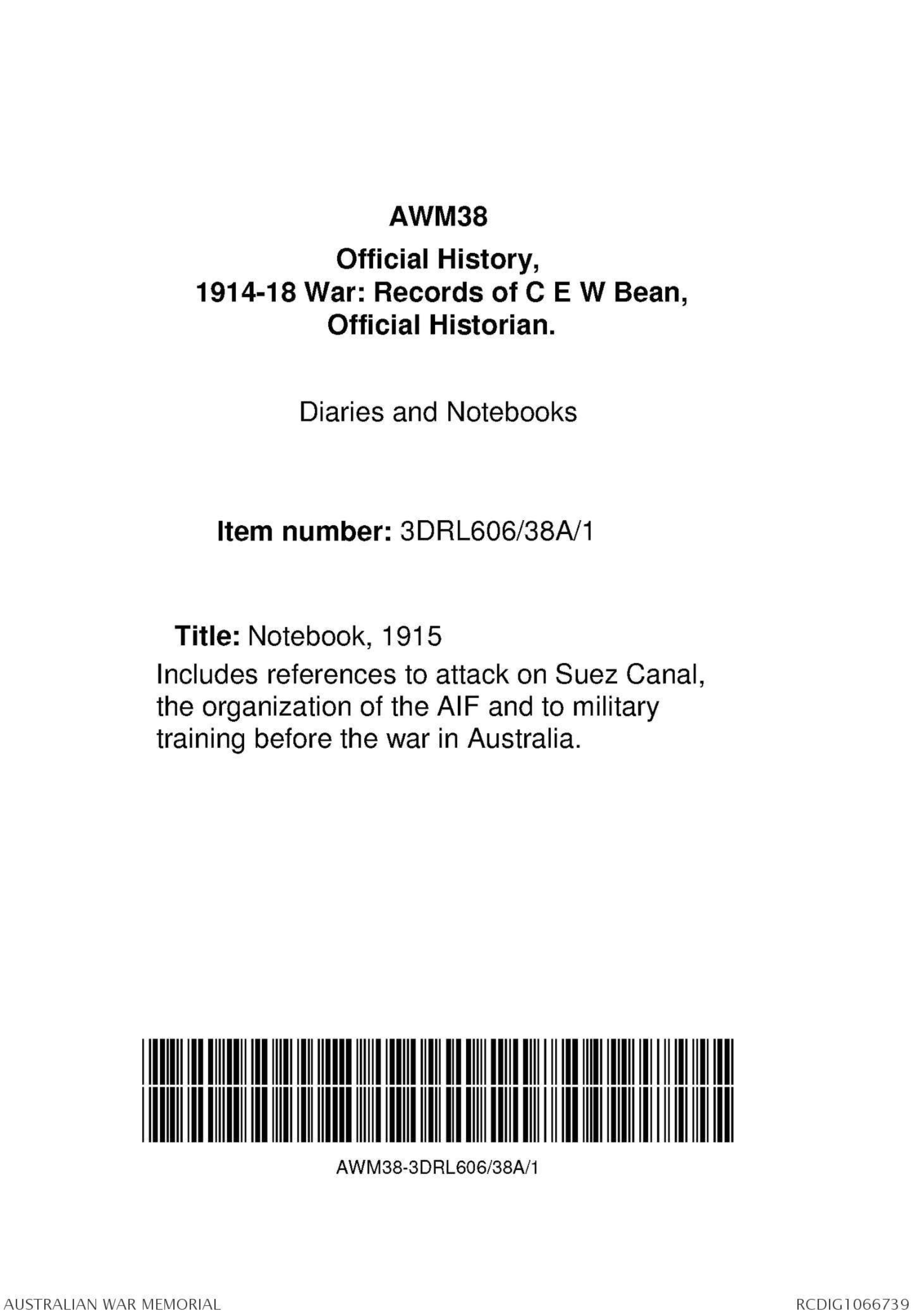
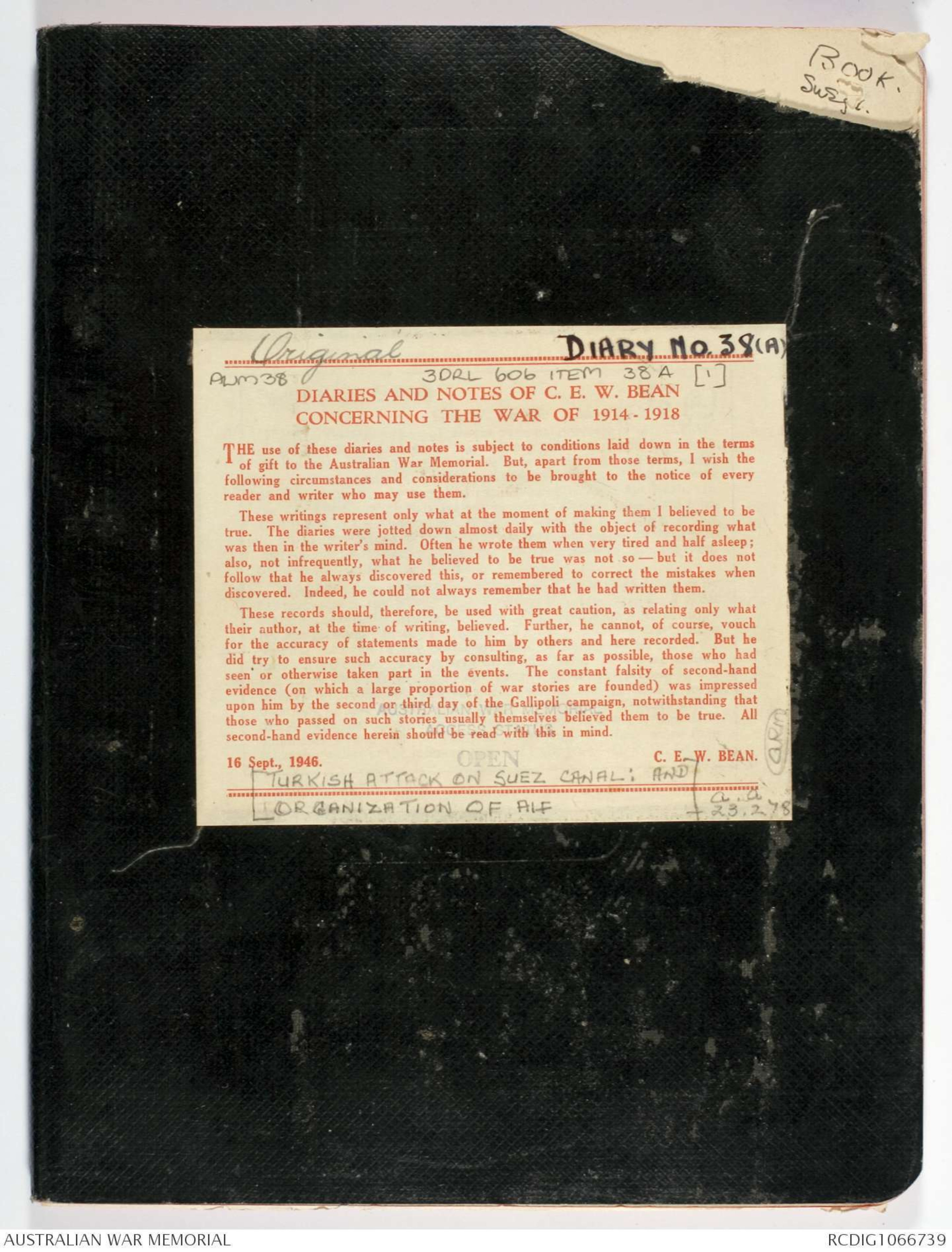
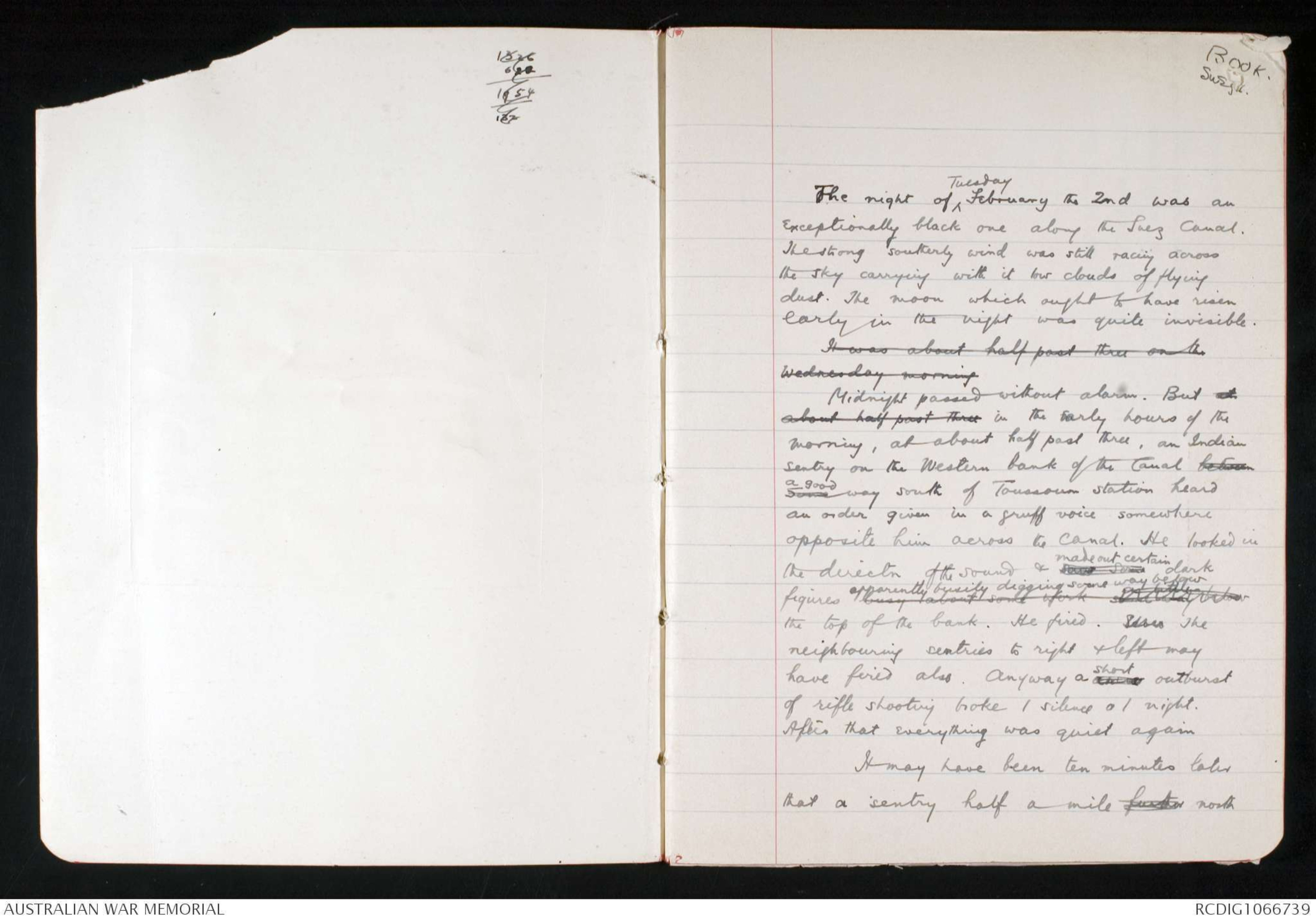
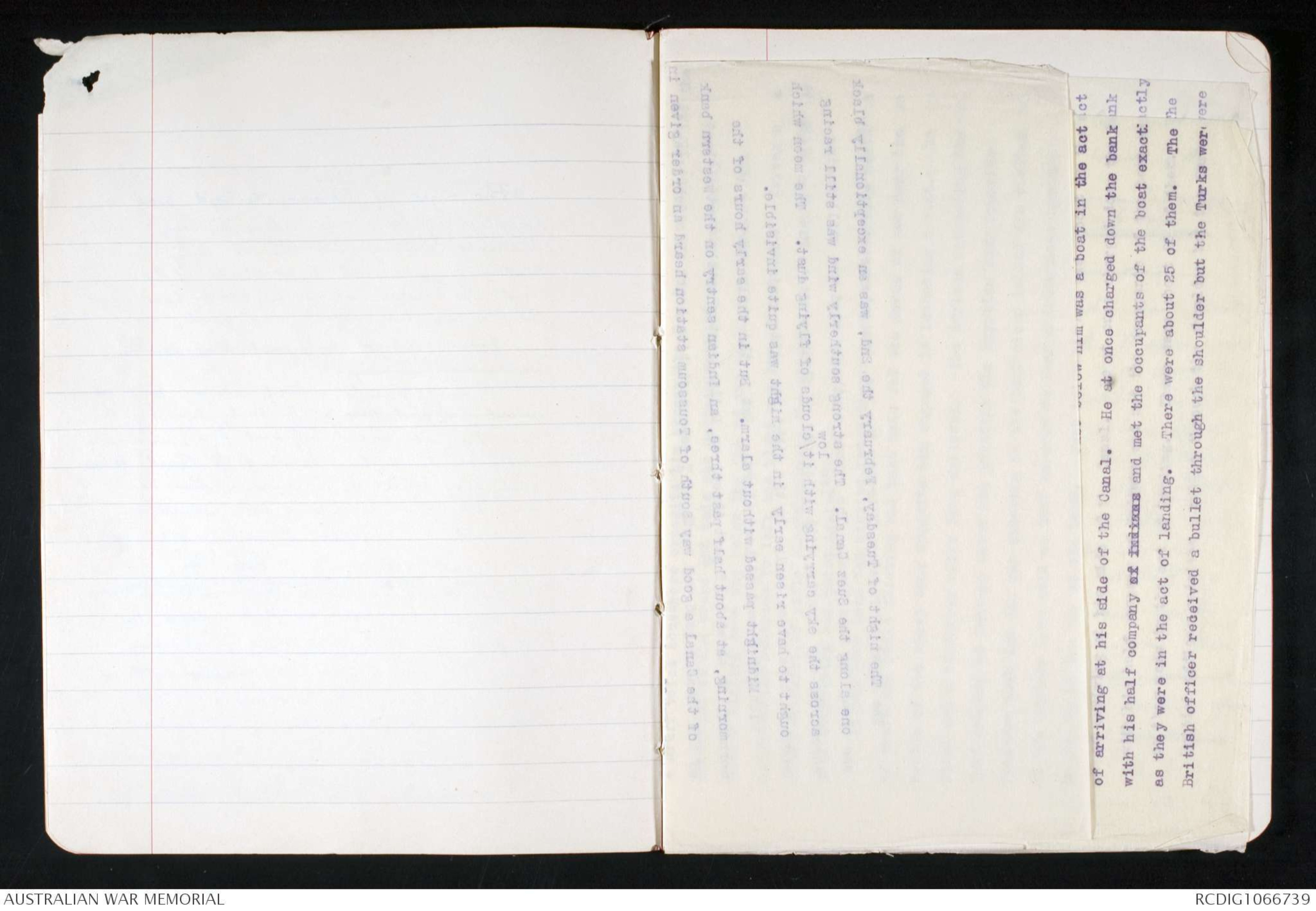
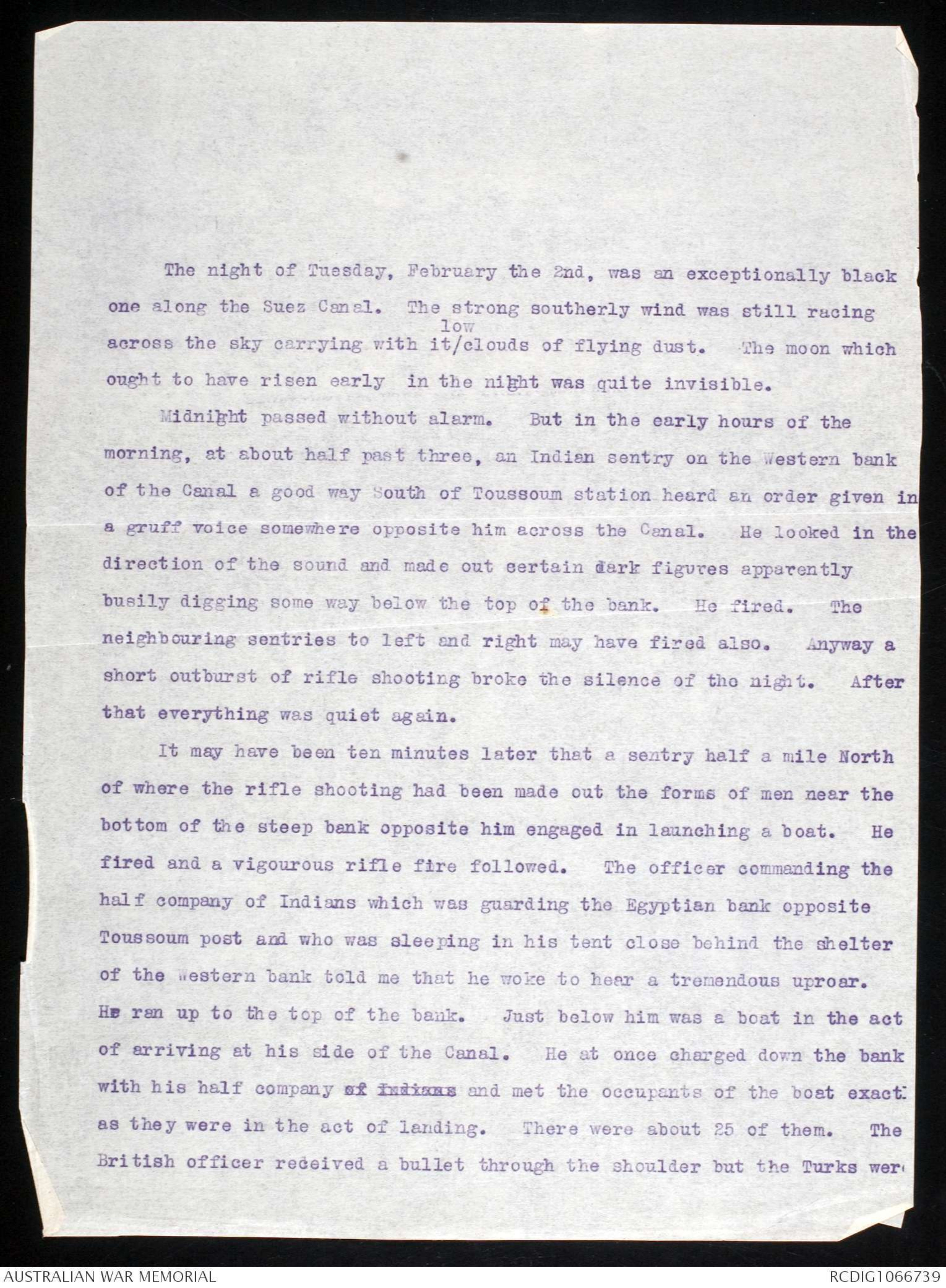
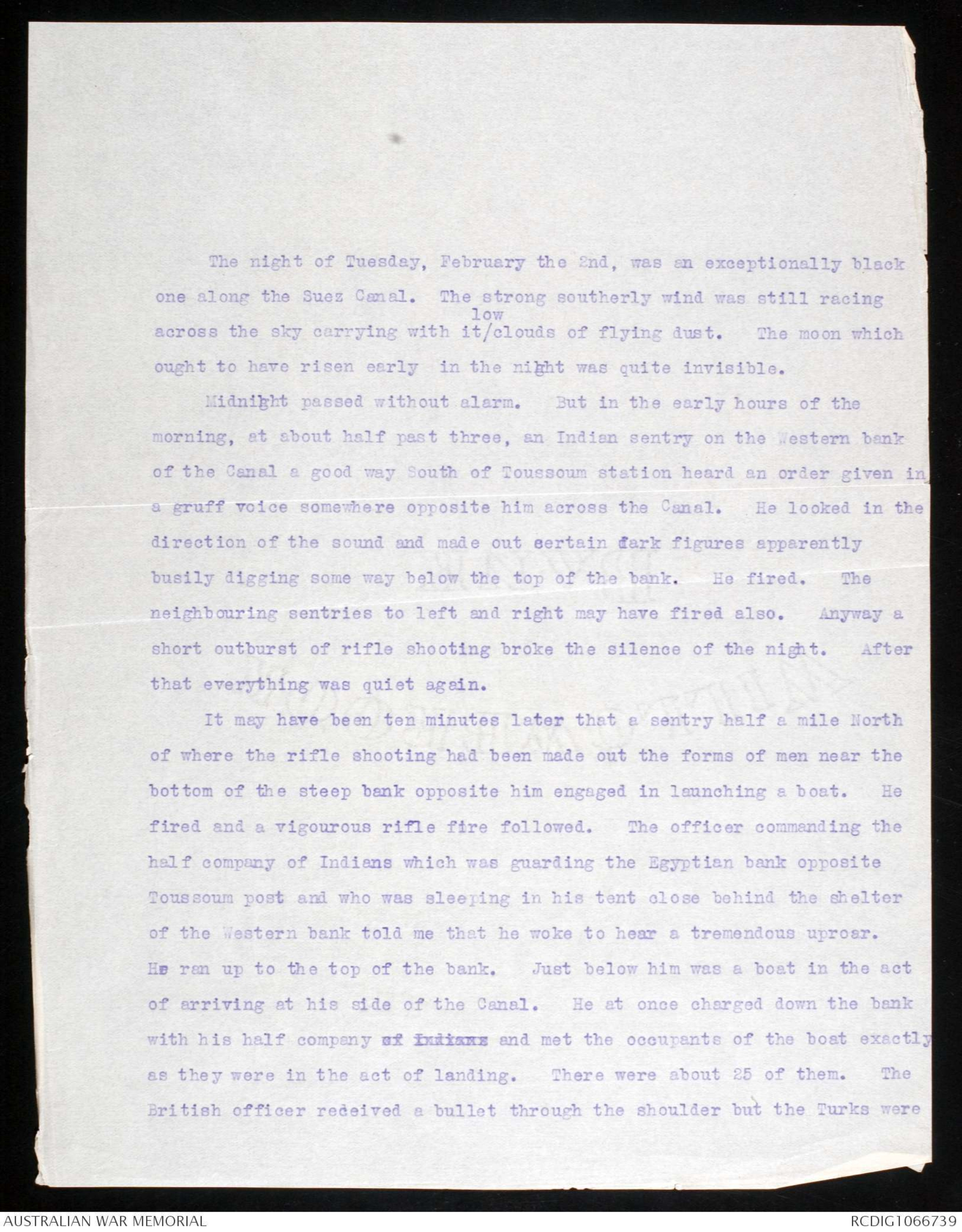
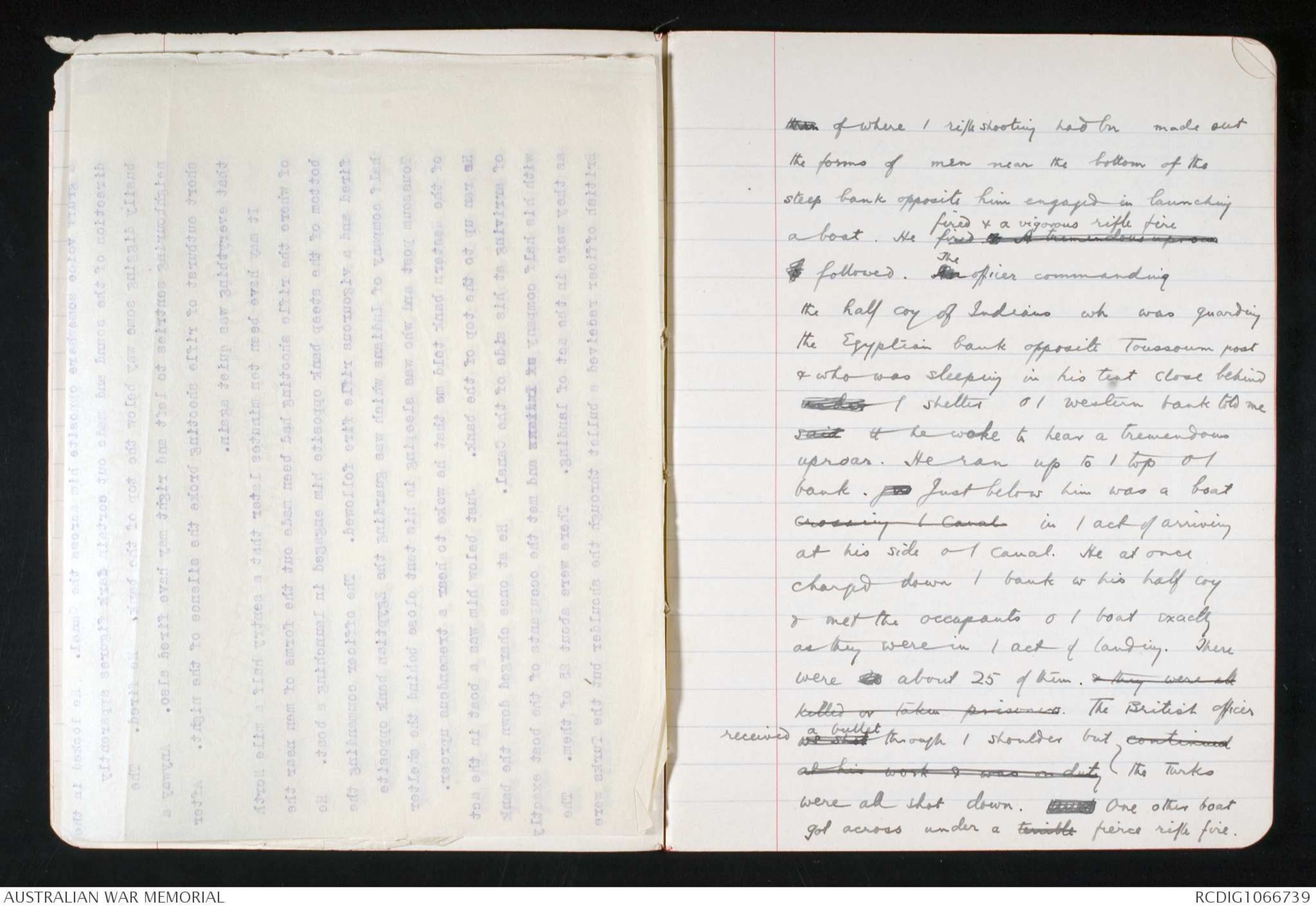
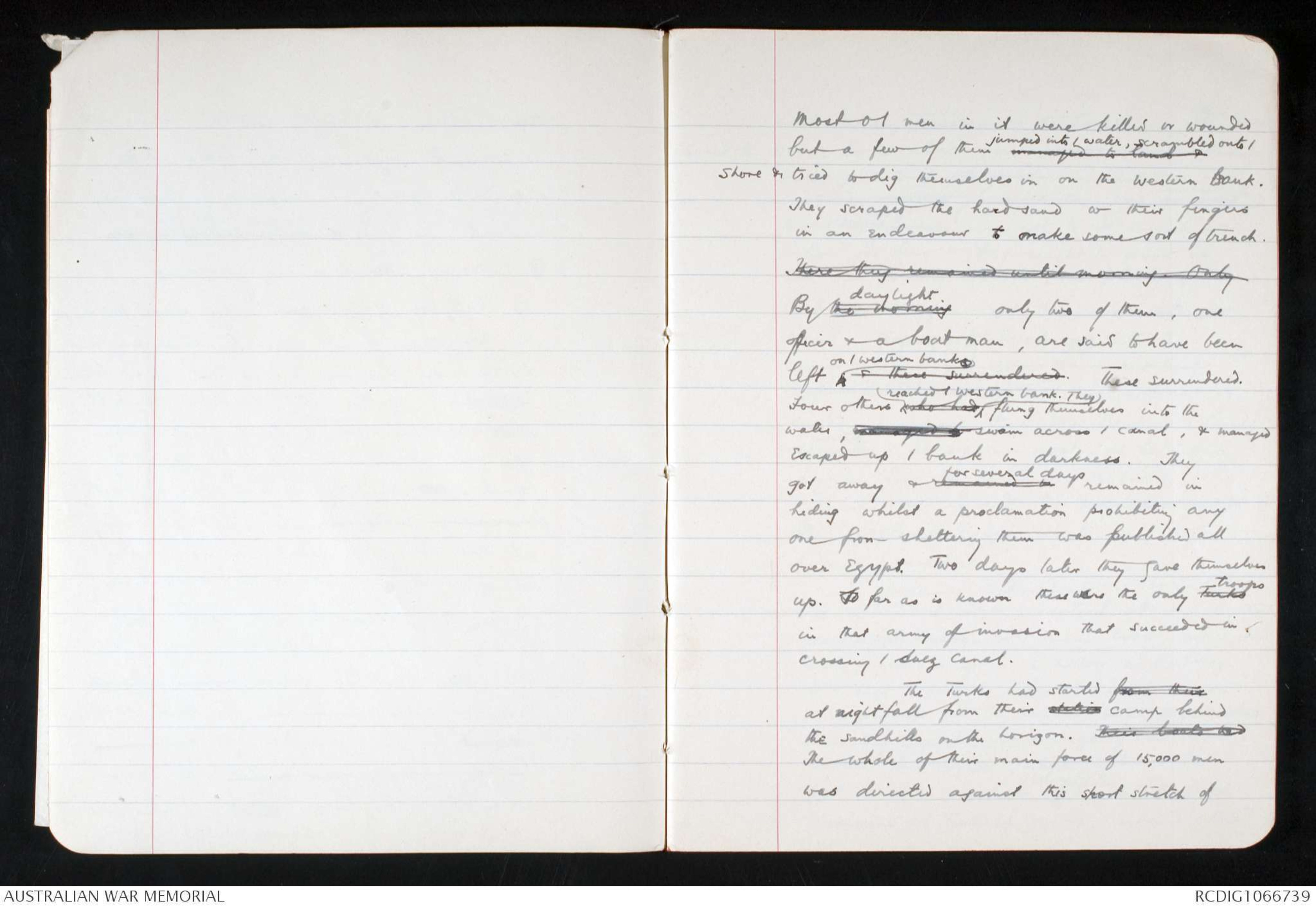
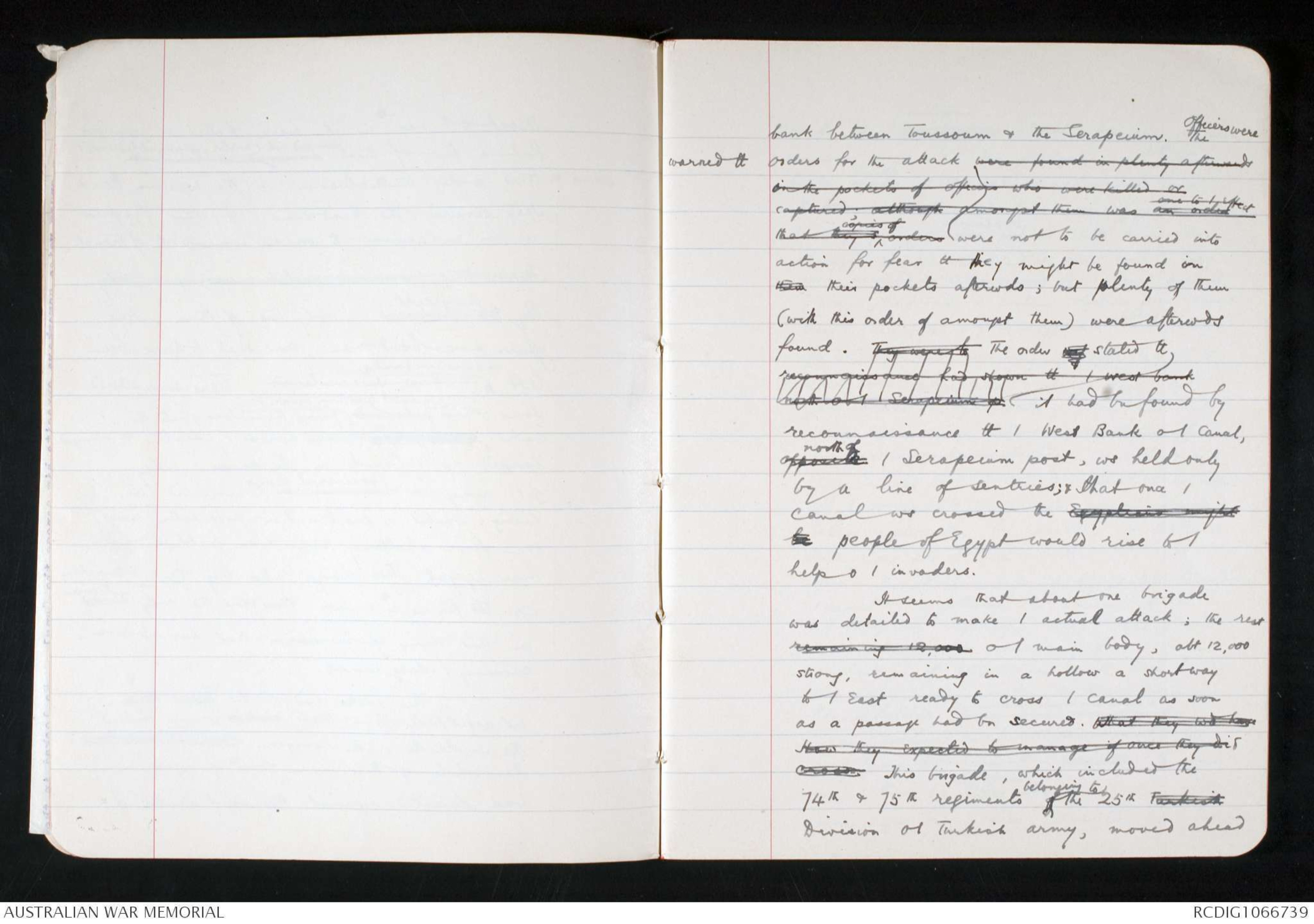
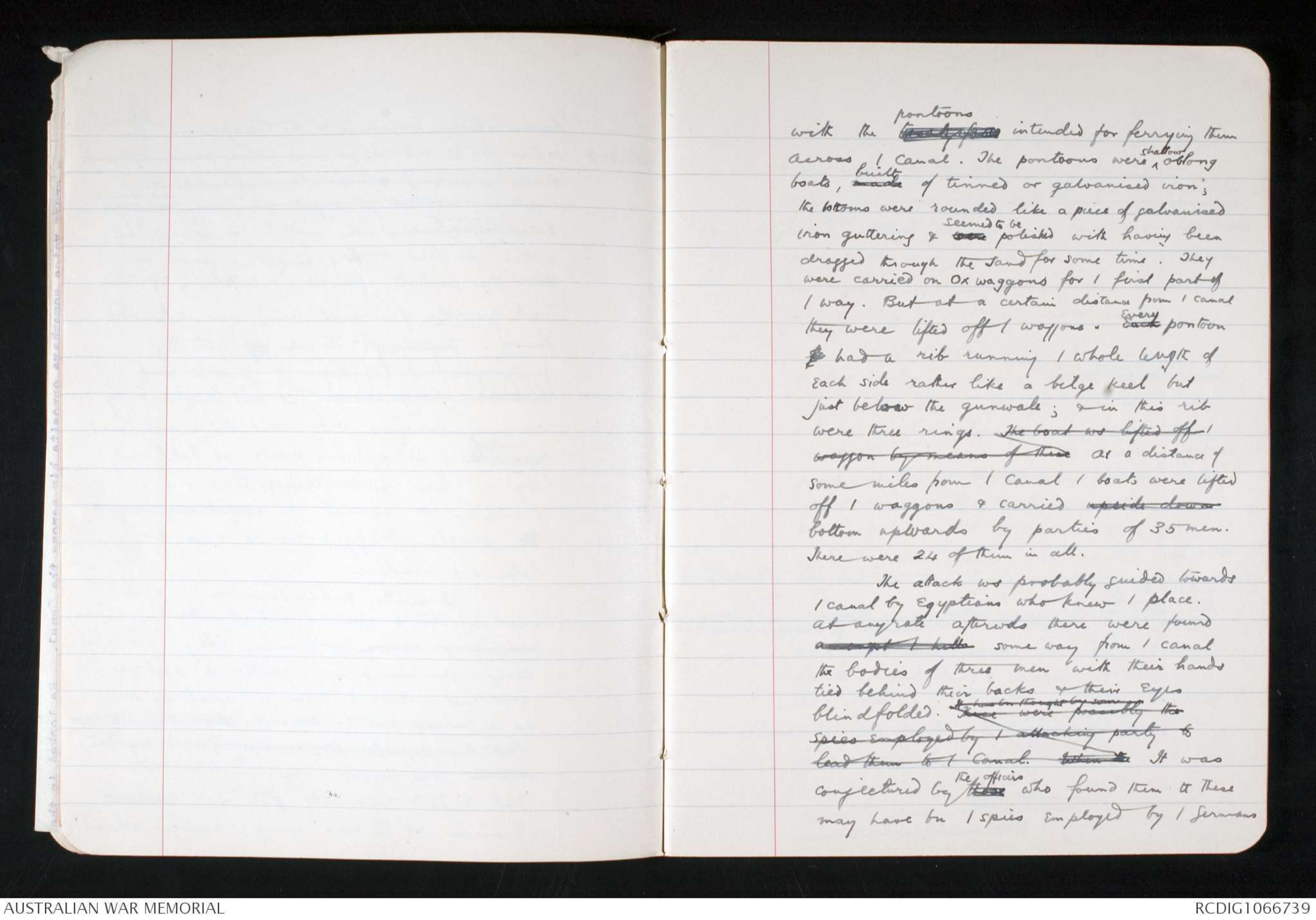
AWM38
Official History,
1914-18 War: Records of C E W Bean,
Official Historian.
Diaries and Notebooks
Item number: 3DRL606/38A/1
Title: Notebook, 1915
Includes references to attack on Suez Canal,
the organization of the AlF and to military
training before the war in Australia.
AWM38-3DRL606/38A/1
BOOK.
Suez [[?]]
Original DIARY No. 38 (A)
AWM 38 3DRL 606 ITEM 38A [1]
DIARIES AND NOTES OF C. E. W. BEAN
CONCERNING THE WAR OF 1914-1918
THE use of these diaries and notes is subject to conditions laid down in the terms
of gift to the Australian War Memorial. But, apart from those terms, I wish the
following circumstances and considerations to be brought to the notice of every
reader and writer who may use them.
These writings represent only what at the moment of making them I believed to be
true. The diaries were jotted down almost daily with the object of recording what
was then in the writer’s mind. Often he wrote them when very tired and half asleep;
also, not infrequently, what he believed to be true was not so —but it does not
follow that he always discovered this, or remembered to correct the mistakes when
discovered. Indeed, he could not always remember that he had written them.
These records should, therefore, be used with great caution, as relating only what
their author, at the time of writing, believed. Further, he cannot, of course, vouch
for the accuracy of statements made to him by others and here recorded. But he
did try to ensure such accuracy by consulting, as far as possible, those who had
seen or otherwise taken part in the events. The constant falsity of second-hand
evidence (on which a large proportion of war stories are founded) was impressed
upon him by the second, or third day of the Gallipoli campaign, notwithstanding that
those who passed on such stones usually themselves believed them to be true. All
second-hand evidence herein should be read with this in mind.
16 Sept, 1946. OPEN C.E.W. BEAN
[TURKISH ATTACK ON SUEZ CANAL: AND
ORGANIZATION OF AIF
[*ARM*]
A.A
- 23.2.78
1326622-----1954------132
BOOK.
Suez [[?]]
The night of ^Tuesday February the 2nd was an
exceptionally black one along the Suez Canal.
The strong southerly wind was still racing across
the sky carrying with it low clouds of flying
dust. The moon which ought to have risen
early in the night was quite invisible.It was about half past three on theWednesday morning
Midnight passed without alarm. But atabout half past three in the early hours of the
morning, at about half past three, an Indian
sentry on the Western bank of the Canal betweensome a good way south of Toussoun station heard
an order given in a gruff voice somewhere
opposite him across the Canal. He looked in
the directn of the sound & saw some made out certain dark
figures busy about some work some way below apparently busily digging some way below
the top of the bank. He fired. Sentr The
neighbouring sentries to right & left may
have fired also. Anyway a outb short outburst
of rifle shooting broke / silence o / night.
After that everything was quiet again
It may have been ten minutes later
that a sentry half a mile further north
... him was a boat in the act
of arriving at his side of the Canal. He at once charged down the bank
with his half company of Indians and met the occupants of the boat exactly
as they were in the act of landing. There were about 25 of them. The
British officer received a bullet through the shoulder but the Turks were
The night of Tuesday, February the 2nd, was an exceptionally black
one along the Suez Canal. The strong southerly wind was still racing
across the sky carrying with it / low clouds of flying dust. The moon which
ought to have risen early in the night was quite invisible.
Midnight passed without alarm. But in the early hours of the
morning, at about half past three, an Indian sentry on the Western bank
of the Canal a good way South of Toussoum station heard an order given in
a gruff voice somewhere opposite him across the Canal. He looked in the
direction of the sound and made out certain dark figures apparently
busily digging some way below the top of the bank. He fired. The
neighbouring sentries to left and right may have fired also. Anyway a
short outburst of rifle shooting broke the silence of the night. After
that everything was quiet again.
It may have been ten minutes later that a sentry half a mile North
of where the rifle shooting had been made out the forms of men near the
bottom of the steep bank opposite him engaged in launching a boat. He
fired and a vigourous rifle fire followed. The officer commanding the
half company of Indians which was guarding the Egyptian bank opposite
Toussoum post and who was sleeping in his tent close behind the shelter
of the Western bank told me that he woke to hear a tremendous uproar.
He ran up to the top of the bank. Just below him was a boat in the act
of arriving at his side of the Canal. He at once charged down the bank
with his half company of Indians and met the occupants of the boat exact
as they were in the act of landing. There were about 25 of them. The
British officer received a bullet through the shoulder but the Turks wer
The night of Tuesday, February the 2nd, was an exceptionally black
one along the Suez Canal. The strong southerly wind was still racing
across the sky carrying with it /low clouds of flying dust. The moon which
ought to have risen early in the night was quite invisible.
Midnight passed without alarm. But in the early hours of the
morning, at about half past three, an Indian sentry on the Western bank
of the Canal a good way South of Toussoum station heard an order given in
a gruff voice somewhere opposite him across the Canal. He looked in the
direction of the sound and made out certain dark figures apparently
busily digging some way below the top of the bank. He fired. The
neighbouring sentries to left and right may have fired also. Anyway a
short outburst of rifle shooting broke the silence of the night. After
that everything was quiet again.
It may have been ten minutes later that a sentry half a mile North
of where the rifle shooting had been made out the forms of men near the
bottom of the steep bank opposite him engaged in launching a boat. He
fired and a vigourous rifle fire followed. The officer commanding the
half company of Indians which was guarding the Egyptian bank opposite
Toussoum post and who was sleeping in his tent close behind the shelter
of the Western bank told me that he woke to hear a tremendous uproar.
Hs ran up to the top of the bank. Just below him was a boat in the act
of arriving at his side of the Canal. He at once charged down the bank
with his half company of Indians and met the occupants of the boat exactly
as they were in the act of landing. There were about 25 of them. The
British officer received a bullet through the shoulder but the Turks were
there of where / rifle shooting had bn made out
the forms of men near the bottom of the
steep bank opposite him engaged in launching
a boat. He fired a tremendous uproar fired & a vigorous rifle fireTh followed. An The officer commanding
the half coy of Indians wh was guarding
the Egyptian bank opposite Toussoum post
& who was sleeping in his tent close behindunder / shelter o / western bank told mesaid tt he woke to hear a tremendous
uproar. He ran up to / top o /
bank. jus Just below him was a boatcrossing / canal in / act of arriving
at his side of / canal. He at once
charged down / bank w his half coy
& met the occupants o / boat exactly
as they were in / act of landing. There
were 20 about 25 of them. & they were allkilled or taken prisioner. The British officer
received ws shot a bullet through / shoulder but continuedat his work & was on duty the Turks
were all shot down. xxxxx One other boat
got across under a terrible fierce rifle fire.
most o / men in it were killed or wounded
but a few of them managed to land & jumped into / water, scrambled onto /
shore & tried to dig themselves in on the Western bank.
They scraped the hard sand w their fingers
in an endeavour to make some sort of trench.Here they remained until morning. Only
By the morning daylight only two of them, one
officer & a boat man, are said to have been
left ∧on / western bank & these surrendered. These surrendered.
Four others ∧reached the western bank. They who had flung themselves into the
water, managed to swam across / canal, & managed
escaped up / bank in darkness. They
got away & remained in for several days remained in
hiding whilst a proclamation prohibiting any
one from sheltering them was published all
over Egypt. Two days later they gave themselves
up. So far as is known these were the only Turks troops
in that army of invasion that succeeded in
crossing / Suez Canal.
The Turks had started from there
at night fall from their station camp behind
the sandhills on the horizon. Their boats had
The whole of their main force of 15,000 men
was directed against this short stretch of
bank between Toussoum & the Serapeium. The Officers were
warned tt orders for the attack were found in plenty afterwardsin the pockets of officers who were killed orcaptured; although amongst them was one to / effect an orderthat ^copies of orders were not to be carried into
action for fear tt they might be found inthem their pockets afterwds; but plenty of them
(with this order of amongst them) were afterwds
found. They were to The order xxx stated tt
reconnaisiance had shown tt / West Banknorth o / Serapeium w it had bn found by
reconnaissance tt / West Bank o / Canal,opposite north of / Serapeium post, ws held only
by a line of sentries; & that once /
canal ws crossed the Egyptians mightbe people of Egypt would rise to /
help o / invaders.
It seems that about one brigade
was detailed to make / actual attack; the restremaining 12,000 o / main body, abt 12,000
strong, remaining in a hollow a short way
to / East ready to cross / canal as soon
as a passage had bn secured. What they wd haveHow they expected to manage if once they didcross This brigade, which included the
74th & 75th regiments ∧belonging to the 25th Turkish
Division of Turkish army, moved ahead
with the twenty five pontoons intended for ferrying them
across / canal. The pontoons were, ^shallow oblong
boats, made built of tinned or galvanised iron;
the bottoms were rounded like a piece of galvanised
iron guttering & were seemed to be polished with having been
dragged through the sand for some time. They
were carried on Ox waggons for / first part of
/ way. But at a certain distance from / canal
they were lifted off / waggons Each Every pontoonI had a rib running / whole length of
each side rather like a bilge keel but
just below the gunwale; & in this rib
were three rings. The boat ws lifted of /waggon by means of these At a distance of
some miles from / Canal / boats were lifted
off / waggons & carried upside down
bottom upwards by parties of 35 men.
There were 24 of them in all.
The attack ws probably guided towards
/ canal by Egyptians who knew / place.
At any rate afterwds there were foundamongst / hills some way from / canal
the bodies of three men with their hands
tied behind their backs & their eyes
blindfolded. It has bn thought by some These were possibly thespies employed by / attacking party tolead them to / canal. When the It was
conjectured by these the officers who found them tt these
may have bn / spies employed by / Germans
 Deb Parkinson
Deb ParkinsonThis transcription item is now locked to you for editing. To release the lock either Save your changes or Cancel.
This lock will be automatically released after 60 minutes of inactivity.